- Author Matthew Elmers [email protected].
- Public 2023-12-16 21:49.
- Last modified 2025-01-24 09:17.

The ScanEagle drone is caught by the patented SkyHook system. The mobile and flexible method of launching and returning this vehicle allows the installation of various equipment while maximizing the use of the volume of the drone on board.
A series of articles will discuss new developments in the field of unmanned aerial vehicles (UAVs), ground mobile robots (NMR) and automatic surface / underwater vehicles (ANA / APA)
2015 was a busy year for the international self-driving vehicle market. The current level of development of UAVs is constantly increasing, as manufacturers are expanding the boundaries of autonomy, flight duration and complexity of onboard equipment, and customers are implementing programs for deploying third-generation systems in new roles, while clarifying the requirements for existing systems.
The NMR sector continues to evolve to meet the needs of the post-Afghan theater of war. (TVD). The emerging threats, along with the prevailing clear need to detect and neutralize rebel bombs and landmines, are forcing the development of new, more advanced systems with increased capabilities, especially when the emphasis is increasingly on national security and immediate response, especially in counterinsurgency operations.
In the field of maritime systems, both in the surface and submarine sectors, new general principles of operations are also being developed, with particular emphasis on enhancing mine action capabilities and finding effective means of countering submarines.

The RQ-4B Global Hawk UAV was created for detailed observation of vast geographic areas and providing military command with real-time information regarding the location of the enemy's human and material resources.
Marine UAVs
The most advanced maritime UAV operator is the US Navy, which operates drones such as the Insilu ScanEagle, Northrop Grumman MQ-8B Fire Scout and the larger MQ-8C Fire Scout currently being tested.
MQ-8B with a payload mass of 137 kg and a flight duration of 7.5 hours played an important role in the development of the general concept of the US Navy for the use of naval UAVs. This drone, which can carry out reconnaissance and illuminate targets with its laser designator, was deployed in Afghanistan in support of counterinsurgency operations of the international coalition.
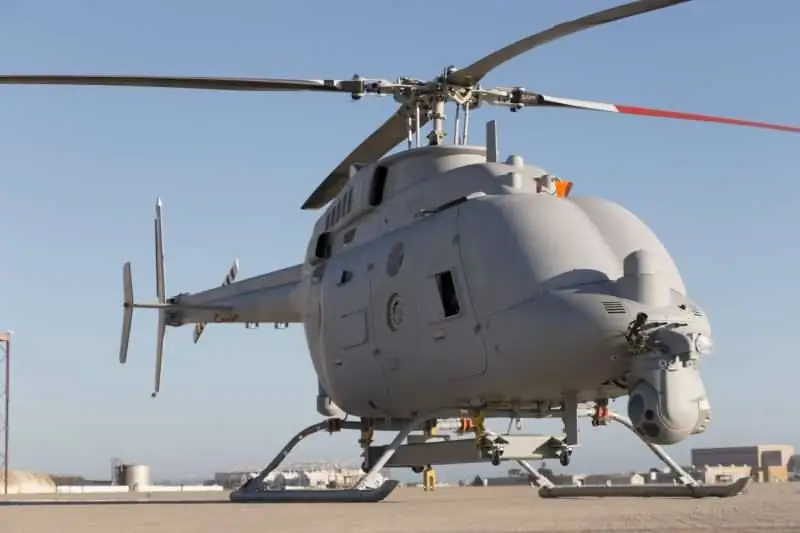
Helicopter-type drone MQ-8C Fire Scout
This UAV was integrated with the advanced high-precision weapon system APKWS (Advanced Precision Kill Weapon System) from BAE Systems. Priority government program that added semi-active laser guidance to the previously unguided air-to-ground Hydra-70 missile mounted on the Bell AM-1Z Viper assault helicopter and the UH-1Y Venom light multipurpose helicopter of the US Marine Corps (KMP), which made it possible to capture targets on land and at sea with high accuracy. The MQ-8B UAV has also played an important role in the development of joint unmanned and manned aircraft operations, allowing the Navy to determine the direction of the development of the corresponding principles of combat use.
The larger MQ-8C UAV, based on the light Bell 407 helicopter, is designed for independent takeoff and landing on any ship with a landing pad, as well as from prepared and unprepared ground sites. The aircraft, which combines the capabilities of the MQ-8B with the payload and performance of a Bell 407 helicopter, flew 11 hours in August 2015 as part of the fleet's operational tests. At the beginning of 2015, the program of test flights was completed, and now the system is ready to undergo an operational readiness assessment by the end of 2016, as soon as the fleet decides on how to integrate this drone into its complex of systems in the coming decade.

The ScanEagle is self-launching with a pneumatic catapult for easy launch at sea and on land
Perception of threat
For the most part, the threat in the maritime realm is asymmetric. Unlike the use of UAVs over the earth's surface, where such devices are mainly designed to create a picture of the environment in which ground forces operate, the marine environment is more reactive. The value of using UAVs in this environment lies in the fact that crews can study potential targets out of range while simultaneously expanding the reconnaissance capabilities of shipborne optoelectronic devices and radars and with a significant reduction in operating costs compared to manned helicopters.
The rapid development of UAVs for the marine environment was also greatly facilitated by threats to national security and the need for patrol vessels to monitor the coastline and defend against threats from the sea. All this is a consequence of the economic, political and cultural problems that have arisen in the maritime sector, which have had to be faced over the past decade. “It is a fact that any landlocked country needs a clear identification of threats from the sea and timely neutralization,” said Dan Beachman, UAV Marketing Director at Israel Aerospace Industries (IAI). "These threats can have small or large effective areas of reflection in accordance with their size and therefore the country's armed forces need accurate capabilities to identify them."
IAI was one of the first companies to turn to the maritime theme, creating in the 80s of the last century the RQ-2A Pioneer and RQ-5 Hunter drones, which worked from American aircraft carriers, adjusting the firing, and subsequently carrying out reconnaissance for the landing force. Today, the company offers two systems in this segment: the Naval Rotary UAV (NRUAV) vertical takeoff and landing aircraft and the Maritime Heron fixed-wing aircraft. Both of them, according to Mr. Beachman, are designed to provide users with an integrated maritime system that matches "the current operational objectives of each country."
The NRUAV is capable of climbing to an altitude of 4600 meters, its range is 150 km, and the maximum flight duration is six hours. It has a maximum speed of 100 knots (185 km / h), a loitering speed of 60 knots (111 km / h) and can carry a load weighing up to 220 kg, consisting of a versatile multi-sensor kit with advanced capabilities. The kit includes day and night optoelectronics, which also provides automatic tracking and range measurement to the target, a multi-mode radar that provides sea surveillance and long-range observation, a synthetic aperture radar (SAR) and an inverse synthetic aperture radar (Inverse SAR) with selection modes for moving ground and air targets, navigation and avoidance of adverse atmospheric phenomena. In addition, the drone can carry either an electronic intelligence sensor or an electronic warfare sensor. The system exchanges information with the ground control station via a data transmission channel within the line of sight.
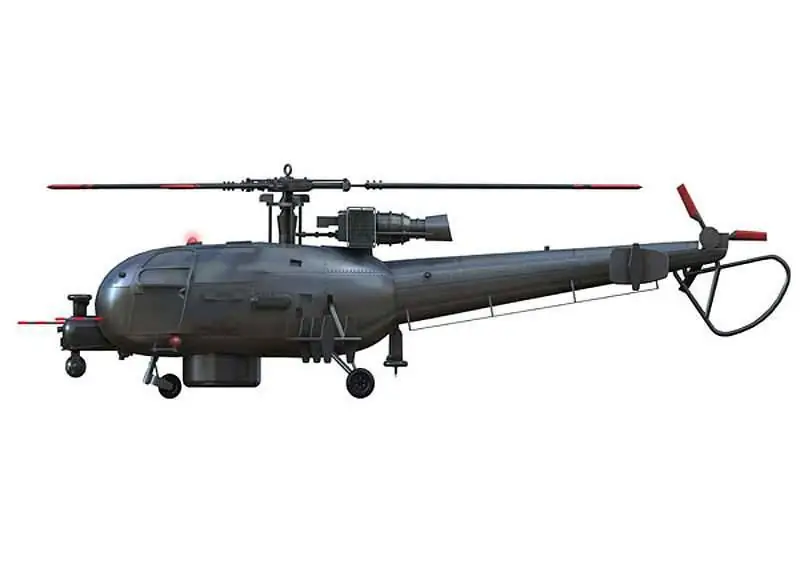
UAV vertical takeoff and landing Naval Rotary UAV (NRUAV)
The NRUAV drone is based on the HeMoS (Helicopter Modification Suite) transformation kit developed by IAI Malat. HeMoS can automatically take off and land from ships, assess combat damage and round-the-clock, over-the-horizon target designation in adverse weather conditions. “The naval UAV meets a wide range of operational needs, such as invaluable in combating illegal fishing, piracy, insurgency and other activities aimed at undermining the country's sovereignty,” Beechman continued. "This highly efficient system makes an important contribution to creating an integrated perception of the maritime environment without risking human lives."
Maritime Heron in its main parameters is very similar to the standard UAV Heron launched from the ground - a MALE class device (Medium Altitude Long Endurance - medium altitude with a long flight duration), but with the additional possibility that the naval version is capable of taking off and landing on an aircraft carrier on one's own. The drone has a wingspan of 16.6 meters and a take-off weight of 1250 kg. The maximum ceiling is 9000 meters and the flight duration is up to 40 hours, depending on the task and configuration of the onboard equipment. The aircraft can carry a wide variety of sensors, and can simultaneously use various instruments and devices in order to transmit up-to-date information about large areas for a long time. In a naval configuration, the UAV carries sensors designed specifically for this environment, including, for example, systems such as an optoelectronic station MOSP (Multi-mission Optronic Stabilized Payload) from IAI, marine radar EL / M-2022 Maritime Patrol Radar (MPR) from IAI ELTA and AIS (Automatic Identification System).
In order to increase operational flexibility, the ground control station of the drone can be based on the ground or ship, and control can be transferred from one station to another in real time. “When working overseas, it is very important to meet specific environmental conditions, operate the platform from any offshore platform and perform a wider range of tasks,” Beechman continued. "The biggest operational advantage lies in the ability to complete the full cycle of the task at hand: detection, classification and identification using one integrated and highly efficient system."
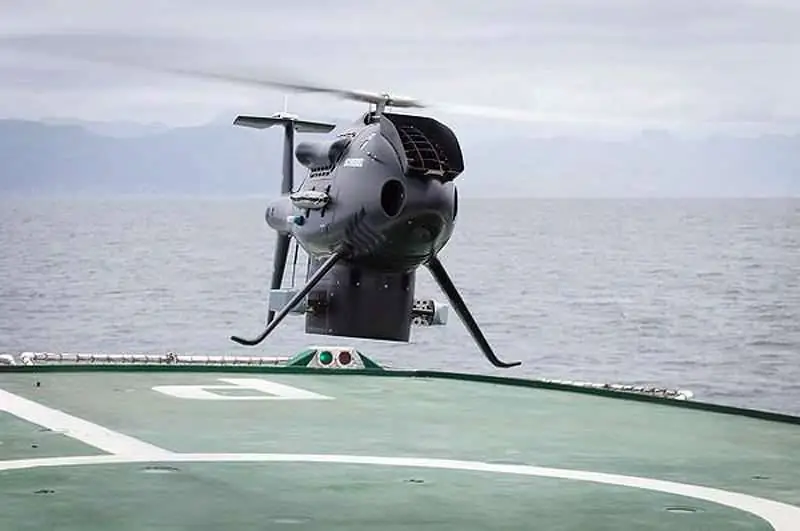
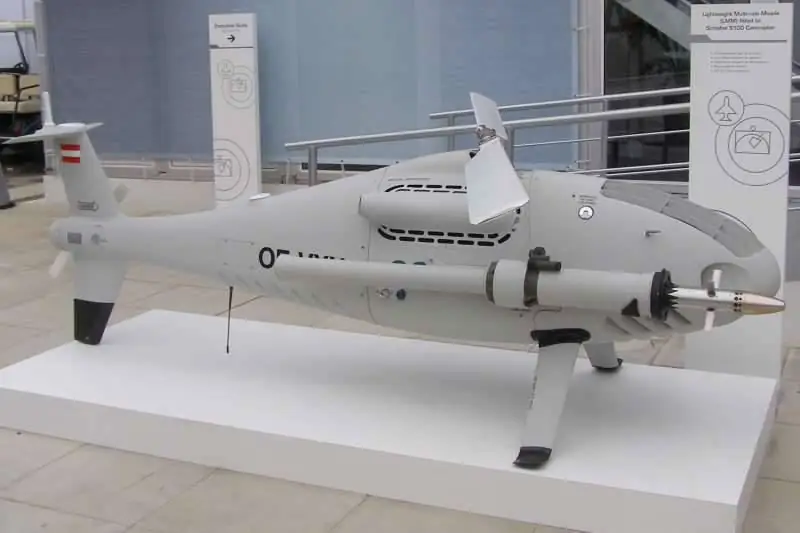
In October 2015, the Schiebel Camcopter S-100 UAV demonstrated its capabilities to interact with a ship of the South African fleet (photo below)
Ocean scan
Today, one of the most successful marine UAVs is ScanEagle, created by Boeing and Insitu. This UAV of an aircraft design can operate at a cruise altitude of 3000 meters for 20 hours, carrying onboard equipment for various operational needs, including optoelectronics, electronic reconnaissance and electronic warfare, communications and repeater, mapping equipment and radar (with synthetic aperture and function selection of ground moving targets).
The ScanEagle launches independently with a pneumatic catapult and returns with the SkyHook system, which sets it apart from other aircraft-type UAVs on the maritime market. A crane installation with a hanging rope loop is installed on board the vessel, when the UAV flies over it is caught with this loop by the wing tip (the scheme resembles a snare for catching birds), the engine is turned off and then the UAV safely returns to the ship by turning the crane installation. “The sea launch and return of ScanEagle is unique; it is truly the only aircraft type UAV currently on the market with extensive operating experience that you can launch and catch on a ship. That's why so many fleets use this unit,”says Andrew Duggan, CEO of Insitu Pacific. - Catapult launch isn't all that unique, but what really sets it apart is the SkyHook system. To return other aircraft-type UAVs to the ship, nets are used, and the problem is that if the net is attached to the ship and the UAV misses, then the drone hits the ship, while with the SkyHook system, the UAV flies parallel to the ship, so if it misses, then simply flies away for one more run."
The ScanEagle drone is in service with the fleets of the United States, Canada, Malaysia and Singapore; in addition, in recent years it has taken part in a number of competitions in order to verify and evaluate performance, including tests carried out by the British navy and most recently by the Australian navy. From Insitu's perspective, the rollout by such well-known operators is definitely helping to move the market forward. “The demand is quite significant, and a lot of it is driven by the unique qualities of ScanEagle. There is quite a lot of competition in the land-based sector, but from a maritime perspective, there are very few vehicles that can reliably launch and return to a ship, Duggan continued. “There is great interest in the fleets that look at the system deployed by the United States, Canada and Singapore and others, and assess its significance from a tactical perspective. This system can greatly help, in particular, those operators who are either limited in space, having a single helicopter hangar on the ship, or do not have any space on board to accommodate a conventional deck helicopter. Even if you don't have a helicopter deck, the use of a ScanEagle drone allows you to get more out of this vessel, in the sense that it now has an aircraft that can conduct aerial surveillance, staying there for up to 15 hours. With the appearance of a UAV on board, the capabilities of this ship for patrolling the exclusive economic zone, conducting search and rescue operations, fighting illegal fishing or pirate ships are instantly expanded. This provides many additional capabilities that the ship's command can take advantage of, so it is perfect for smaller ships, such as corvettes or patrol boats, which cannot accommodate a helicopter."
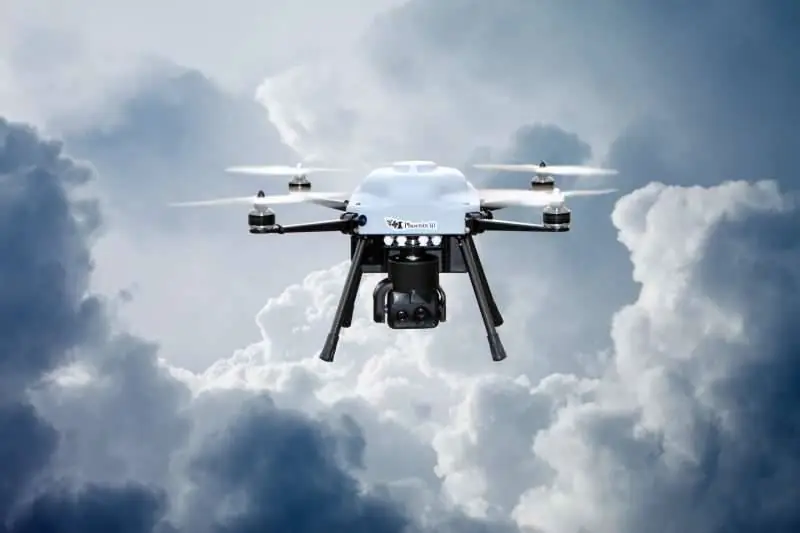
Quadrocopter Phoenix-30 vertical take-off and landing is designed to collect information for military, operational services and civilian structures

A high-resolution photograph taken by the Schiebel Camcopter S-100 heliport is transmitted to the control station in real time
Testing
The trend, which has affected all fleets and aimed at increasing the number of smaller vessels with fewer crews, is also expanding the capabilities of UAVs with vertical take-off and landing, which Schiebel did not fail to take advantage of with its S-100 Camcopter heliport. The S-100 UAV has undergone extensive testing in many fleets, including the last tests of the Australian fleet in June 2015 and the South African fleet in October 2015. Australian Navy trials focused on the S-100's multi-sensor capabilities to demonstrate how the system can be effectively used to support maritime and coastal reconnaissance. The Australian Navy, for example, was shown how a combination of the S-100 drone and three major systems, including the L-3 Wescam MX-10 camera and SAGE ESM and PicoSAR radars, can expand the over-the-horizon coverage of ships and increase situational awareness.
During the tests of the South African fleet, carried out off the coast of South Africa, the Schiebel S-100 heliport with the SAGE ESM system was launched from the deck of the hydrographic research vessel Protea in order to demonstrate the capabilities of this UAV to perform sea reconnaissance and anti-piracy tasks (two main areas of interest for this fleet). In order to expand the range of tasks performed, Schiebel is working to expand the range of onboard systems available for the S-100. Intelligence sensors are able to detect the radars of other vessels and thus identify potential threats in the surrounding area. Chris Day, UAV project manager at Schiebel, said the company is committed to offering advanced capabilities in this area. “We have flown a couple of radars over the past few years, but they are not optimized for sea conditions, they were designed for land and have additional capabilities to work at sea, but this may be too big a compromise. There are several companies developing very light, state-of-the-art radars that are specifically designed for maritime environments. Selex is one of them, and we continue to cooperate with it on testing new radars, which will give us a very long range and the ability to simultaneously monitor many targets."
In June 2015, Schiebel also teamed up with IAI ELTA Systems to demonstrate the EL / K-7065 3D high-frequency (3-30 GHz) radio interception and geolocation system (3D) on board the S-100 heliport. The EL / K-7065 system provides fast marking and identification of high-frequency signals, generating a reliable list of detected electronic systems and their precise coordinates, while the onboard short wave antenna measuring only 300 mm to 500 mm is optimal for the S-100 drone. “The reality and the problem we are facing is that some individuals or groups operating at sea do not want anyone to know what they are up to; Their ships do not have radar and are often not even made of metal, which makes them difficult to detect,”says Mr Dey. “Therefore, one of the ways to identify threats is to intercept messages. Even if they have very primitive seaworthy means, they still need to communicate, coordinate, so these technologies of interception of communications and location determination can give the commander a clue when no other technologies are working anymore. Schiebel recently tested a heavy fuel oil engine for its S-100 as it strives to meet the needs of the marine systems market. The new engine, which is a modified commercial rotary piston engine, is designed to address the problem of a wide variety of fuels in marine systems. The new engine will now be able to run on JP-5 (F-44), Jet A1 (F-35) and JP-8 (F-34).

The export version of the AirMule drone, known as the Cormorant, is currently being tested.
From container
A completely new approach was taken by Lockheed Martin, which, as part of the development of a small-sized marine UAV launched from a container, is working on a reconfigurable version of its Vector Hawk folding-wing UAV. The Vector Hawk UAV has a takeoff weight of 1.8 kg and a vertical profile of 101 mm; its configuration can vary from a fixed wing system to a vertical takeoff system or to a tiltrotor system to meet different operational requirements. The company believes that this system is well suited as a portable package solution, which includes an aircraft type aircraft for standard and long-term missions, a folding wing aircraft that can be launched from a tube guide from the ground or from the water, a vertical take-off and landing vehicle, and finally, a tiltrotor-type apparatus. “What we are working on has to do with our efforts to achieve consistency. We want a vehicle that has one fuselage, avionics and control systems, but multiple wing options so that it can dynamically adapt to different types of missions,”said Jay McConville, head of unmanned systems business development at Lockheed Martin."One of these wing configurations is a retractable wing, which is great for launching from a launch pod."
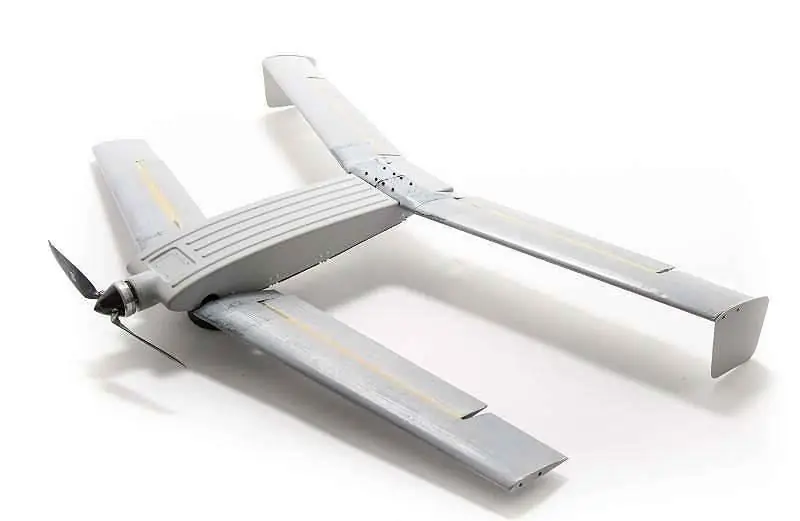
The Vector Hawk drone can have several configurations
Container launch is an interesting way to launch small UAVs and has the potential to have a ton of applications in the maritime area. The advantages of this method are the ability to launch vehicles from different locations with difficult environmental conditions. “Take the launch of an apparatus from a container, after launch, it is deployed in flight, while making it easier for the operator,” continued McConville. - The number of places from where you can make launches is also increasing; Imagine launching from under water or from the air or many other scenarios, all the operator has to do is set the sequence of start commands and the system will cope with the environmental conditions in this scenario on its own. The Vector Hawk drone lands in the same way as the widespread Desert Hawk UAV, diving sharply and then smoothly standing in front of the ground or, in our case, water. In order to reduce the loads acting on the drone during landing, the design provides for its division into parts; in addition, all parts have a buoyancy reserve and therefore it can be picked up from the surface and assembled again into one apparatus.
As the market for marine UAVs gains momentum, there are more clearly defined principles for the application of these systems. Among the many advantages available on the market for drones, sailors are looking for the systems that best suit their needs and will enhance the capabilities of marine vessels and keep their crews safe from danger.
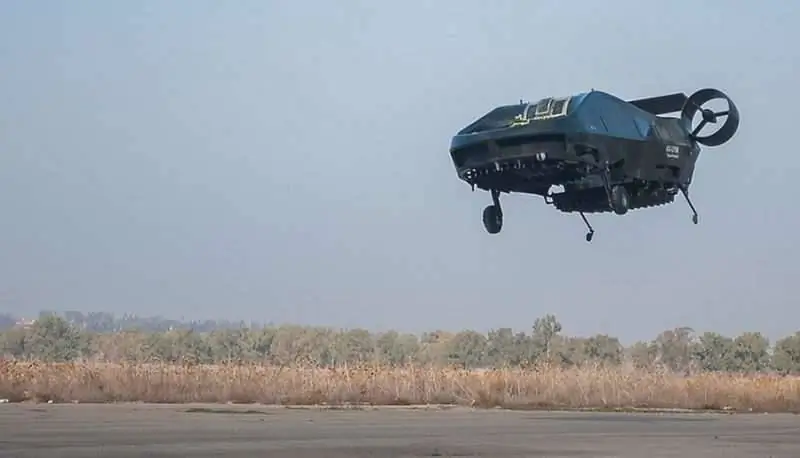
Tactical Robotics' AirMule UAV successfully completed its first untethered flight at Israel's Megido airfield in December 2015
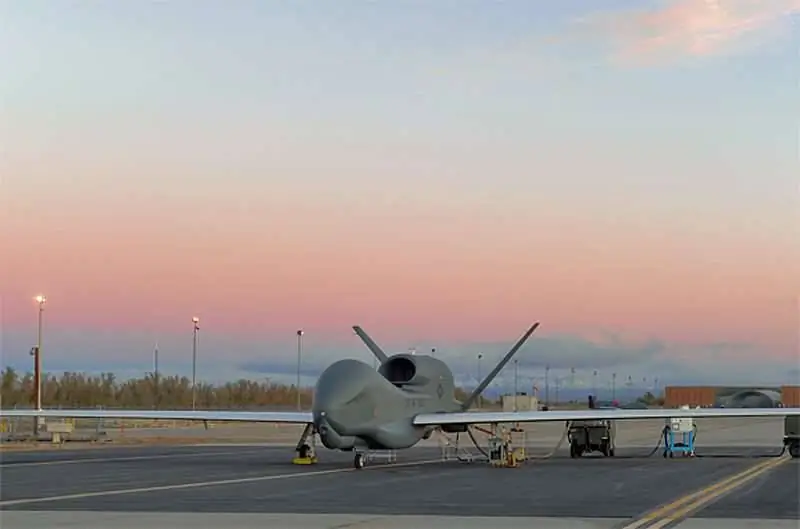
The US Air Force RQ-4B Clobal Hawk UAV successfully passed the intermediate test stage in May 2015






